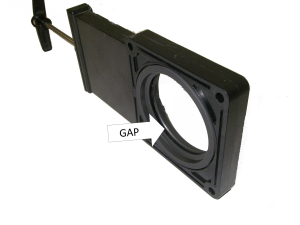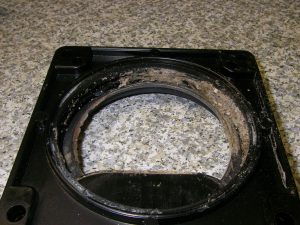The RV industry standard dump valve found on most RVs, especially 5th wheels is a manual cable pull style, knife gate valve. Most people have issues with them within the first 6 months, and the first indication is when they remove the sewer cap to install the sewer hose, they get sewage all over their shoes! What a surprise! Electric valves are our preferred solution because they work and keep you clean!

What exactly happened? It turns out the valve design has a couple of short comings.
1. The Seal Gap. If you were to have the valve in hand, a new one, with the knife gate closed, and the 2 seals on either side of the gate, then opened it, you would notice a slight gap between the seals.

This gap will allow some water to get back into the body of the valve when it is in the open position. This water is contaminated.
2. The cable pull valve has to be mounted in the side of the piping, in the 3 o’clock or 9 o’clock position so the gate slides back and forth like a pocket door in a house. The contaminated water in the body has no place to go so it sits, dries out, leaving a scum in the track the gate slides in.

Debris in Gate Valve
Usually there is no issue opening a cable pull, the issue is on closing. What happens is when the cable is pushed, it has to exert enough pressure on the gate to overcome the now sticky track that the gate slides in. When the gate does begin to move, it runs smack into the seals which have to spread, to allow the gate to pass to the closed position—which it doesn’t get to, before the pressure stops the gate and the cable flexes, instead of continuing its push.
When we discovered this issue years ago, we informed our customers about the problem and recommended the valve be mounted in the 10 o’clock to 2 o’clock position over the piping. The reason is quite simply, water flows downhill! Luckily, electric valves alleviate some of these problems by automating the process.
Let’s take a trip. The water inside the holding tanks builds pressure as it rises creating pressure on the gate of the valve. Most gate valves will withstand pressure equal to a 10 foot high column of water which creates 4 times the pressure any RV holding tank could produce, so pressure on the gate is not an issue.
THE TECHNICAL NITTY GRITTY
We all connect to the sewer inlet with the proper 3″ sewer hose, (we will address other methods later) and we push the button in our case, to open the valve. The water begins to push the air in the piping downstream of the valve, creating a back pressure (momentarlily PSI) which is short lived, but in time that water can get back into the valve body. Not a flood of water because there is air in the body already, but a few drops. Then all of a sudden the back pressure PSI turns into full flow GPM. At this point, if the valve is installed over the drain pipe, the water flowing past the seals creates a slight venturi action, which helps the water in the body run down and out the piping.
Back pressure creates the issue and full flow helps remove unwanted water from the body. If this can’t happen, the water stays in the body of the valve, allowing the contaminates in the water to settle in the small track the slide gate rides in. This causes the slide gate to stick, taking more pressure to open it, which in the case of the cable pull, causes it to flex instead of pushing the gate, so it doesn’t make it all the way closed. You get to experience the result of this when you remove the cap to put on your sewer hose.
If you’ve had enough of your cable pull valves, we can help! Electric valves are simple, easy, long-lasting.
Do you have a cable pull? Do you have electric valves? Leave a comment with your experience!